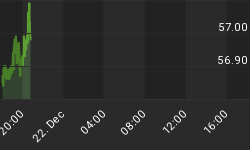The Rydex family of mutual funds is a group of mutual funds that is favored by market timers. Rydex has funds that bet with and against the markets, and if a trader really has conviction as to which way the market may go, they can also leverage that position or belief.
One of my favorite and easiest indicators to work with is the Rydex leveraged asset data. In this instance, we are comparing the amount of assets in those funds that are bullish oriented and leveraged to the amount of assets in funds that are bearish and leveraged. Rydex has four bearish and leveraged index funds covering the S&P500, Dow Industrials, NASDAQ, and Russell 2000. There are 6 bullish and leveraged index funds covering the same 4 markets. The anomaly comes from the fact that there are two S&P500 funds and two Russell 2000 funds each with 1.5x and 2x leverage.
So how do we use this data? The Rydex asset data is only a small, yet representative sample, of what the average trader or market timer is doing with their money. Despite these limitations, the general belief is that we should bet against the Rydex market timer, and the leveraged bull and bear asset data tends to support that notion.
Currently, the total assets in the leveraged bull funds is still above those in the leveraged and bearish funds, but if you are a contrarian and trying to get bullish, the trend is clearly headed in the right direction. We can see this from figure 1, a daily chart of the QQQQ that compares the amount of Rydex leveraged bullish (green) and bearish (red) assets.
Figure 1. Rydex Leverage Assets
We want to buy the market when there are more leveraged bears than bulls or when the red line is greater than the green line. We are close but not there yet.
In fact, let's design a study where we do that. We go long when there are more leveraged bears than bulls and we close out the position when there are more leveraged bulls than bears. I will apply the study to the QQQQ and the look back is to February, 2002. Prior to this time and since the data started (April, 2001) the leveraged bears were never greater than the leveraged bulls.
This strategy generated 36 QQQQ points; over the same time period, buy and hold QQQQ yielded 10 QQQQ points. There were 51 total trades and 90% were profitable!!! The average trade lasted between 6 and 7 trading days. The MAE graph is shown in figure 2 (next page).
As a refresher, MAE stands for Maximum Adverse Excursion, and this graph shows every trade from the strategy. What does the MAE measure? If you are like most traders, you put on a trade, and then you watch that position move adverse to your entry point as very few individuals always pick the exact bottom tick. MAE is how much in percentage terms the trade loses before it turns around to become a winner or is closed out as a loser.
For example, the trade in the MAE graph with the blue box around it had a MAE of almost 4% (x- axis); this trade did recover, and it was closed out for a 6% winner (y- axis). We know it was a winner because it is a green caret.
So what does this MAE graph tell us? 43 out of 51 trades had individual draw downs less than 3%. The majority of the mega- draw down trades were from 2002.
Figure 2. MAE Graph
The Rydex leveraged bull and bear asset data is pointing towards a market bottom or a tradeable bounce. Failure of a bounce to occur would be telling, and in a market environment characterized by strong inflationary pressures, I believe a failed signal is a strong possibility.
I don't mean to sound wishy washy regarding market direction, but I am just trying to identify the pertinent trading issues. Remember, I deal in probabilities not certainties.
To learn more about our quantitative and disciplined investment approach please visit www.thetechnicaltake.com and sign up for our free weekly newsletter and downloads.
Guy M. Lerner may be reached at guy@thetechnicaltake.com
That's TheTechnicalTake!!
I hope you have found my commentary insightful and profitable.















